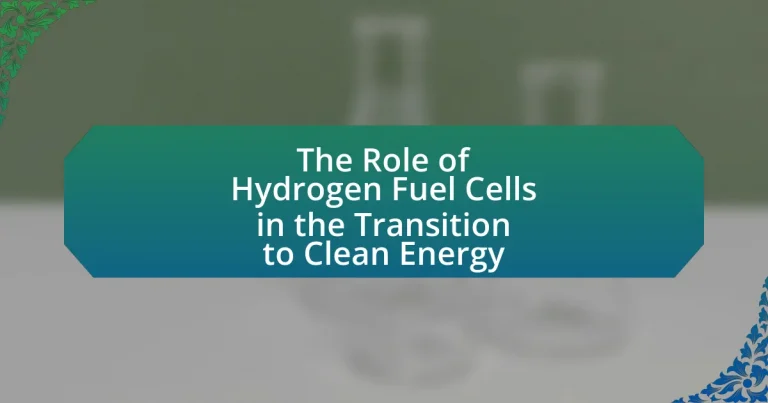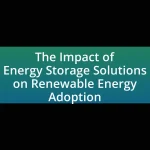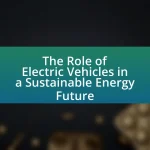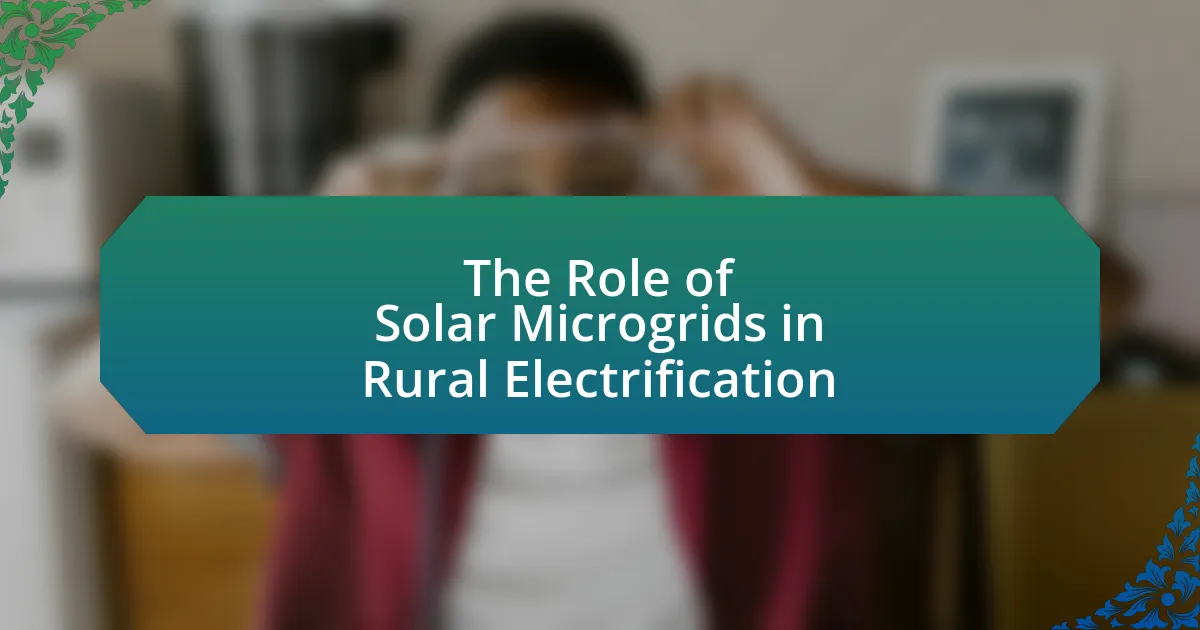Hydrogen fuel cells are electrochemical devices that convert hydrogen and oxygen into electricity, producing only water and heat as byproducts, making them a clean energy technology. The article explores the operation of hydrogen fuel cells, their key components, and the various types, including Proton Exchange Membrane Fuel Cells and Solid Oxide Fuel Cells, highlighting their efficiencies and applications in sustainable energy. It also addresses the importance of hydrogen fuel cells in reducing greenhouse gas emissions, their role in sustainable transportation, and the economic implications of adopting this technology. Additionally, the article discusses the challenges and technological barriers to widespread adoption, the impact of current infrastructure, safety concerns, and the supportive role of policy and regulation in promoting hydrogen fuel cell development.
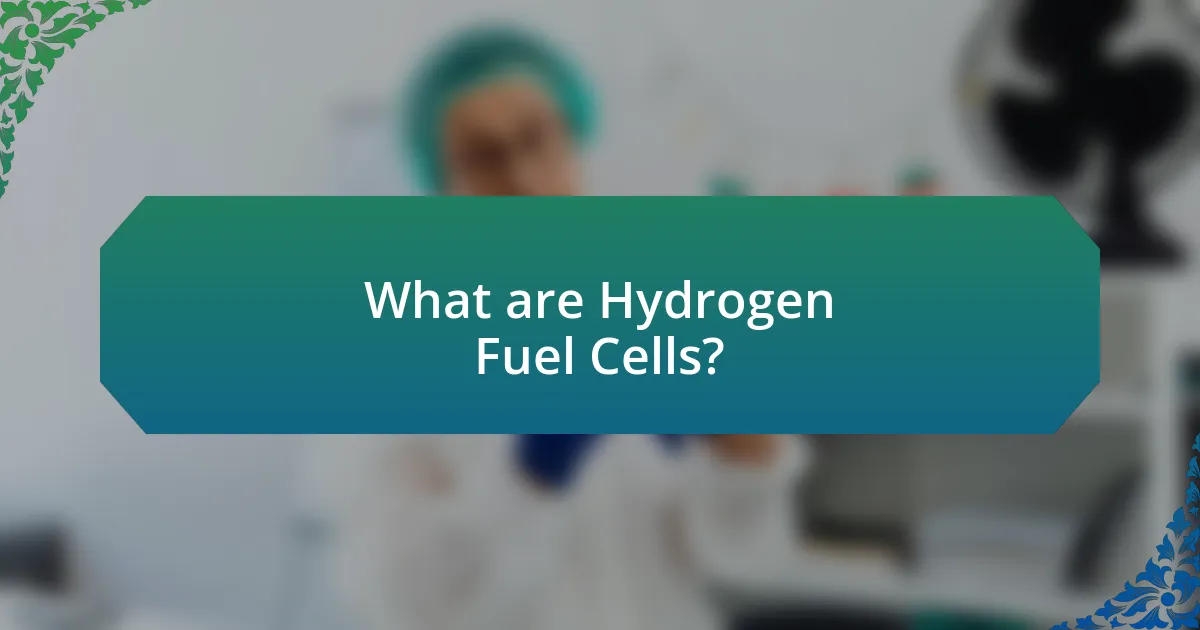
What are Hydrogen Fuel Cells?
Hydrogen fuel cells are electrochemical devices that convert hydrogen and oxygen into electricity, with water and heat as the only byproducts. This process occurs through a reaction in the fuel cell, where hydrogen gas is fed into the anode side, and oxygen (usually from air) is supplied to the cathode side. The reaction generates electricity, which can be used to power electric motors or charge batteries. Hydrogen fuel cells are considered a clean energy technology because they produce zero emissions at the point of use, contributing to the reduction of greenhouse gases and reliance on fossil fuels. According to the U.S. Department of Energy, hydrogen fuel cells can achieve efficiencies of up to 60% in converting fuel to electricity, making them a promising option for sustainable energy solutions.
How do Hydrogen Fuel Cells operate?
Hydrogen fuel cells operate by converting chemical energy from hydrogen and oxygen into electrical energy through an electrochemical reaction. In this process, hydrogen gas is supplied to the anode, where it is split into protons and electrons. The protons pass through a proton exchange membrane to the cathode, while the electrons travel through an external circuit, generating electricity. At the cathode, oxygen combines with the protons and electrons to produce water and heat as byproducts. This technology is validated by the fact that hydrogen fuel cells emit only water vapor and heat, making them a clean energy source, as demonstrated in various applications, including transportation and stationary power generation.
What are the key components of a Hydrogen Fuel Cell?
The key components of a hydrogen fuel cell are the anode, cathode, electrolyte, and external circuit. The anode is where hydrogen gas is supplied and split into protons and electrons. The electrolyte allows only protons to pass through while blocking electrons, which travel through the external circuit, creating an electric current. The cathode is where oxygen is introduced, and it combines with the protons and electrons to produce water and heat as byproducts. These components work together to convert chemical energy from hydrogen into electrical energy efficiently, making hydrogen fuel cells a viable option for clean energy solutions.
How does the electrochemical process in Hydrogen Fuel Cells work?
The electrochemical process in hydrogen fuel cells generates electricity through the reaction of hydrogen and oxygen. In this process, hydrogen gas is supplied to the anode, where it is split into protons and electrons by a catalyst. The protons pass through the electrolyte membrane to the cathode, while the electrons travel through an external circuit, creating an electric current. At the cathode, oxygen from the air combines with the protons and electrons to form water, which is the only byproduct of this reaction. This efficient conversion of chemical energy into electrical energy is fundamental to the operation of hydrogen fuel cells, making them a clean energy source.
What types of Hydrogen Fuel Cells exist?
There are several types of hydrogen fuel cells, primarily categorized into Proton Exchange Membrane Fuel Cells (PEMFC), Solid Oxide Fuel Cells (SOFC), Alkaline Fuel Cells (AFC), and Phosphoric Acid Fuel Cells (PAFC). PEMFCs are widely used in transportation due to their high efficiency and low operating temperature, typically around 80°C. SOFCs operate at higher temperatures, around 600-1000°C, making them suitable for stationary power generation. AFCs, which operate at lower temperatures, are often used in space applications and have a long history of use. PAFCs, operating at approximately 150-200°C, are commonly used for combined heat and power applications. Each type has distinct characteristics that make them suitable for specific applications in the clean energy transition.
What are the differences between PEMFC and SOFC?
PEMFC (Proton Exchange Membrane Fuel Cell) and SOFC (Solid Oxide Fuel Cell) differ primarily in their operating temperatures and electrolyte materials. PEMFC operates at low temperatures, typically between 60 to 80 degrees Celsius, using a polymer membrane as the electrolyte, which allows for quick start-up and high power density. In contrast, SOFC operates at high temperatures, around 600 to 1000 degrees Celsius, utilizing a solid ceramic electrolyte, which enables it to use a wider range of fuels, including natural gas and biogas, but results in slower start-up times and lower power density. These fundamental differences impact their applications, efficiency, and overall suitability for various energy systems.
How do different types of Hydrogen Fuel Cells impact efficiency?
Different types of hydrogen fuel cells impact efficiency through variations in their design and operational characteristics. For instance, Proton Exchange Membrane Fuel Cells (PEMFCs) typically offer higher efficiency at lower temperatures, making them suitable for automotive applications, while Solid Oxide Fuel Cells (SOFCs) operate at high temperatures and achieve higher overall efficiency, particularly in stationary power generation. The efficiency of PEMFCs can reach up to 60% under optimal conditions, whereas SOFCs can exceed 70% efficiency when utilizing waste heat for cogeneration. These differences in efficiency are crucial for determining the appropriate application of each fuel cell type in the transition to clean energy.
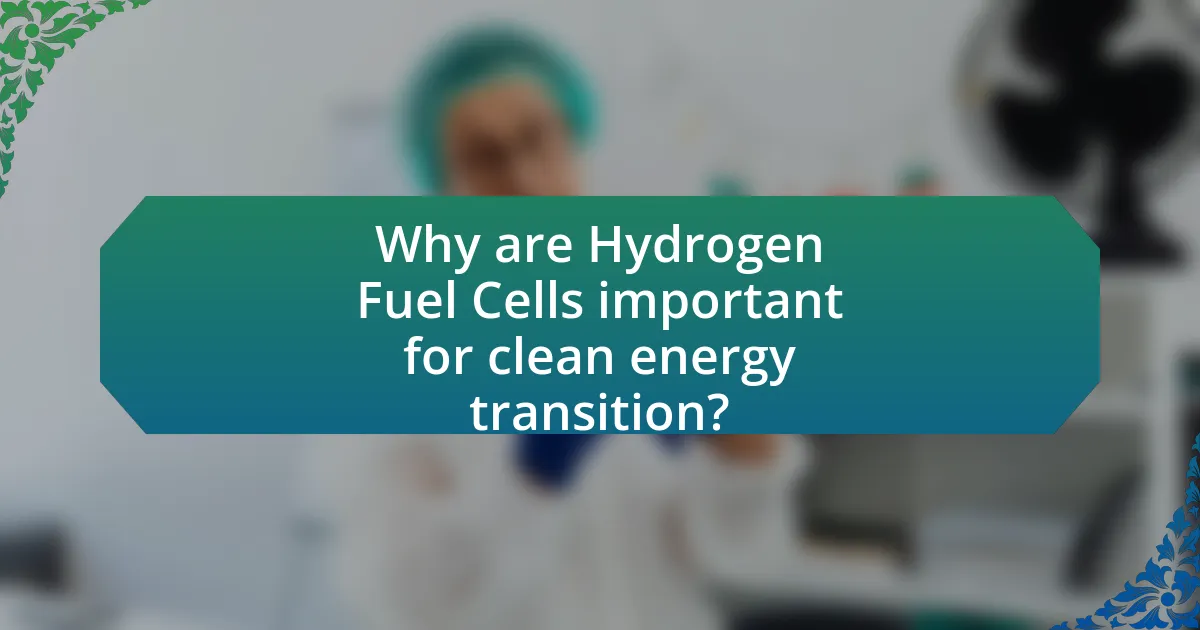
Why are Hydrogen Fuel Cells important for clean energy transition?
Hydrogen fuel cells are important for the clean energy transition because they provide a zero-emission power source that can replace fossil fuels in various applications. These fuel cells convert hydrogen and oxygen into electricity, with water as the only byproduct, thus significantly reducing greenhouse gas emissions. According to the International Energy Agency, hydrogen could account for up to 18% of global energy demand by 2050, highlighting its potential role in decarbonizing sectors like transportation, industry, and heating. This transition is crucial for meeting climate targets and achieving sustainable energy systems.
How do Hydrogen Fuel Cells contribute to reducing greenhouse gas emissions?
Hydrogen fuel cells contribute to reducing greenhouse gas emissions by generating electricity through a chemical reaction between hydrogen and oxygen, producing only water vapor as a byproduct. This process eliminates carbon dioxide and other harmful emissions typically associated with fossil fuel combustion. According to the U.S. Department of Energy, hydrogen fuel cells can achieve efficiencies of up to 60%, significantly higher than traditional internal combustion engines, which typically operate at around 20% efficiency. By replacing fossil fuels in transportation and power generation, hydrogen fuel cells can play a crucial role in decreasing overall greenhouse gas emissions and supporting a transition to cleaner energy sources.
What role do Hydrogen Fuel Cells play in sustainable transportation?
Hydrogen fuel cells play a crucial role in sustainable transportation by providing a clean energy source that emits only water vapor as a byproduct. This technology enables vehicles to operate with high efficiency and long ranges, making them suitable alternatives to traditional fossil fuel-powered vehicles. According to the U.S. Department of Energy, hydrogen fuel cell vehicles can achieve a range of over 300 miles on a single tank, comparable to gasoline vehicles, while significantly reducing greenhouse gas emissions. Additionally, hydrogen can be produced from renewable sources, further enhancing its sustainability credentials.
How can Hydrogen Fuel Cells support renewable energy integration?
Hydrogen fuel cells can support renewable energy integration by providing a means to store and convert excess renewable energy into usable power. When renewable sources like wind and solar generate more energy than is needed, hydrogen fuel cells can utilize this surplus to produce hydrogen through electrolysis. This hydrogen can then be stored and later converted back into electricity when demand increases or renewable generation decreases. For instance, the International Energy Agency (IEA) reports that hydrogen can play a crucial role in balancing supply and demand in energy systems, particularly as the share of variable renewable energy sources grows. This capability enhances grid stability and facilitates a smoother transition to a clean energy future.
What are the economic implications of adopting Hydrogen Fuel Cells?
Adopting hydrogen fuel cells has significant economic implications, including potential job creation, reduced reliance on fossil fuels, and the stimulation of new markets. The hydrogen economy could generate approximately 30 million jobs globally by 2030, as reported by the Hydrogen Council. Additionally, hydrogen fuel cells can lower energy costs by providing a cleaner alternative to traditional energy sources, which can lead to decreased volatility in energy prices. Furthermore, investments in hydrogen infrastructure, estimated to reach $300 billion by 2030, can drive economic growth and innovation in related sectors, such as transportation and manufacturing. These factors collectively indicate that the transition to hydrogen fuel cells can enhance economic stability and promote sustainable development.
How do Hydrogen Fuel Cells create job opportunities in the clean energy sector?
Hydrogen fuel cells create job opportunities in the clean energy sector by driving demand for skilled labor in manufacturing, installation, and maintenance. The growth of hydrogen technology necessitates a workforce proficient in engineering, research and development, and production processes. For instance, the International Energy Agency reported that the hydrogen sector could create up to 30 million jobs globally by 2030, highlighting the potential for economic expansion. Additionally, as governments invest in hydrogen infrastructure, such as fueling stations and production facilities, local economies benefit from job creation in construction and related services.
What are the cost considerations for implementing Hydrogen Fuel Cells?
The cost considerations for implementing hydrogen fuel cells include the initial investment, operational expenses, and infrastructure development. Initial investment costs are significant, with estimates ranging from $1,000 to $3,000 per kilowatt for fuel cell systems, depending on the technology and scale. Operational expenses involve maintenance and hydrogen production costs, which can vary based on the source of hydrogen, with green hydrogen being more expensive than fossil fuel-derived hydrogen. Infrastructure development costs are also substantial, as establishing hydrogen refueling stations and distribution networks requires significant capital investment, often exceeding millions of dollars per station. These factors collectively influence the economic viability of hydrogen fuel cells in the clean energy transition.
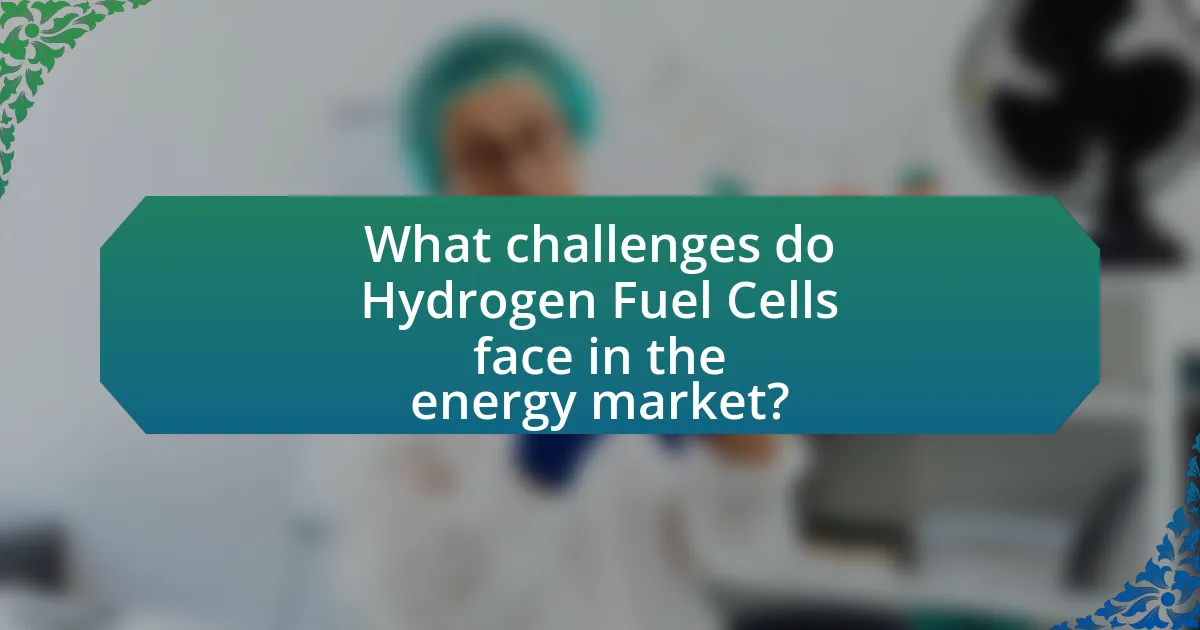
What challenges do Hydrogen Fuel Cells face in the energy market?
Hydrogen fuel cells face significant challenges in the energy market, primarily due to high production costs, limited infrastructure, and competition from other energy sources. The production of hydrogen, especially through green methods like electrolysis, remains expensive, with costs around $5 to $6 per kilogram, making it less competitive compared to fossil fuels and other renewable energy sources. Additionally, the lack of widespread refueling infrastructure hampers the adoption of hydrogen fuel cell vehicles, as only a few hundred hydrogen stations exist globally, primarily in regions like California and Japan. Furthermore, hydrogen competes with battery electric vehicles, which have seen rapid advancements and cost reductions, making them more appealing to consumers. These factors collectively hinder the growth and integration of hydrogen fuel cells in the energy market.
What are the technological barriers to widespread Hydrogen Fuel Cell adoption?
The technological barriers to widespread hydrogen fuel cell adoption include high production costs, limited infrastructure, and efficiency challenges. High production costs stem from the current methods of hydrogen generation, primarily steam methane reforming, which is expensive and carbon-intensive. Limited infrastructure is evident in the scarcity of hydrogen refueling stations, which hampers the practicality of hydrogen fuel cell vehicles. Efficiency challenges arise from the energy losses associated with hydrogen production, storage, and conversion back to electricity in fuel cells, making it less efficient compared to battery electric vehicles. These factors collectively hinder the scalability and economic viability of hydrogen fuel cells in the clean energy transition.
How does the current infrastructure impact Hydrogen Fuel Cell deployment?
The current infrastructure significantly impacts Hydrogen Fuel Cell deployment by determining the availability of production, storage, and distribution systems necessary for widespread adoption. For instance, the lack of refueling stations limits the operational range of hydrogen fuel cell vehicles, which in turn affects consumer acceptance and market growth. According to the U.S. Department of Energy, as of 2023, there are only about 50 hydrogen refueling stations in the United States, compared to over 150,000 gasoline stations, highlighting the disparity in infrastructure support. Additionally, existing natural gas pipelines can be adapted for hydrogen transport, but this requires investment and regulatory changes, which can slow down deployment. Therefore, the current infrastructure directly influences the feasibility and attractiveness of hydrogen fuel cells as a clean energy solution.
What safety concerns are associated with Hydrogen Fuel Cells?
Hydrogen fuel cells pose several safety concerns primarily due to the flammability and explosiveness of hydrogen gas. Hydrogen is highly flammable, with a lower explosive limit of 4% in air, meaning that concentrations above this threshold can ignite easily. Additionally, hydrogen can leak from storage tanks or fuel cell systems, creating risks of fire or explosion, especially in confined spaces. The National Fire Protection Association has established guidelines for the safe handling and storage of hydrogen to mitigate these risks, emphasizing the importance of proper ventilation and leak detection systems. Furthermore, the high-pressure storage of hydrogen increases the risk of catastrophic failure if tanks are compromised. These safety concerns necessitate stringent safety protocols and engineering controls in the design and operation of hydrogen fuel cells.
How can policy and regulation support Hydrogen Fuel Cell development?
Policy and regulation can support hydrogen fuel cell development by providing financial incentives, establishing safety standards, and creating a favorable market environment. Financial incentives, such as tax credits and grants, can lower the cost of research and development, making it more attractive for companies to invest in hydrogen technologies. Establishing safety standards ensures that hydrogen fuel cells are safe for public use, which builds consumer confidence and encourages adoption. Additionally, regulations that promote renewable energy sources can create a market demand for hydrogen fuel cells, as seen in countries like Germany, where government policies have significantly boosted the hydrogen sector, leading to a 50% increase in investment from 2019 to 2020.
What incentives exist for promoting Hydrogen Fuel Cell technology?
Incentives for promoting Hydrogen Fuel Cell technology include government subsidies, tax credits, and grants aimed at reducing the cost of research and development. For instance, the U.S. Department of Energy has allocated funding through initiatives like the Hydrogen and Fuel Cell Technologies Office, which supports projects that advance hydrogen production, storage, and utilization. Additionally, many countries offer tax incentives for businesses that invest in hydrogen infrastructure, such as refueling stations, to encourage adoption. These financial incentives are designed to stimulate innovation and accelerate the transition to cleaner energy sources, as evidenced by the increasing number of hydrogen fuel cell vehicles on the road, which grew by over 50% in 2020 alone.
How can government initiatives enhance public acceptance of Hydrogen Fuel Cells?
Government initiatives can enhance public acceptance of Hydrogen Fuel Cells by providing financial incentives, funding research and development, and implementing educational campaigns. Financial incentives, such as tax credits and subsidies for hydrogen fuel cell vehicles, lower the cost barrier for consumers, making the technology more accessible. Research and development funding can lead to advancements in hydrogen production and storage, improving efficiency and safety, which builds public trust. Educational campaigns can inform the public about the environmental benefits and safety of hydrogen fuel cells, addressing misconceptions and increasing awareness. For instance, the U.S. Department of Energy has invested over $1 billion in hydrogen and fuel cell technologies, demonstrating a commitment to advancing this clean energy solution and fostering public confidence.
What are best practices for integrating Hydrogen Fuel Cells into existing systems?
Best practices for integrating hydrogen fuel cells into existing systems include conducting a thorough feasibility study, ensuring compatibility with current infrastructure, and implementing safety protocols. A feasibility study assesses the technical and economic viability of hydrogen fuel cells, which is crucial for informed decision-making. Compatibility with existing systems, such as electrical grids or transportation networks, ensures seamless integration and operational efficiency. Safety protocols, including proper storage and handling of hydrogen, are essential due to its flammability and the high pressures involved in storage. These practices are supported by industry standards and guidelines, such as those from the International Electrotechnical Commission, which emphasize the importance of safety and compatibility in hydrogen applications.
